OUR HERITAGE: A BRIEF HISTORY OF THE U.S. MARINE CORPS
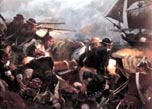 On November 10, 1775, the Second Continental Congress
meeting in Philadelphia passed a resolution stating that
"two Battalions of Marines be raised" for service as
landing forces with the fleet. This resolution
established the Continental Marines and marked the birth
date of the United States Marine Corps. Serving on land
and at sea, these first Marines distinguished themselves
in a number of important operations, including their
first amphibious raid into the Bahamas in March 1776,
under the command of Captain Samuel
Nicholas. The first commissioned officer in the
Continental Marines, Nicholas remained the senior Marine
officer throughout the American Revolution and is
considered to be the first Marine Commandant. The Treaty
of Paris in April 1783 brought an end to the
Revolutionary War and as the last of the Navy's ships
were sold, the Continental Navy and Marines went out of
existence.
On November 10, 1775, the Second Continental Congress
meeting in Philadelphia passed a resolution stating that
"two Battalions of Marines be raised" for service as
landing forces with the fleet. This resolution
established the Continental Marines and marked the birth
date of the United States Marine Corps. Serving on land
and at sea, these first Marines distinguished themselves
in a number of important operations, including their
first amphibious raid into the Bahamas in March 1776,
under the command of Captain Samuel
Nicholas. The first commissioned officer in the
Continental Marines, Nicholas remained the senior Marine
officer throughout the American Revolution and is
considered to be the first Marine Commandant. The Treaty
of Paris in April 1783 brought an end to the
Revolutionary War and as the last of the Navy's ships
were sold, the Continental Navy and Marines went out of
existence.
Following the Revolutionary War and the formal re-establishment of the Marine Corps on 11 July 1798, Marines saw action in the quasi-war with France, landed in Santo Domingo, and took part in many operations against the Barbary pirates along the "Shores of Tripoli" Marines took part in numerous naval operations during the War of 1812, as well as participating in the defense of Washington at Bladensburg, Maryland, and fought alongside Andrew Jackson in the defeat of the British at New Orleans.
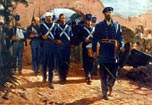 The decades following the War of 1812 saw the Marines
protecting American interests around the world, in the
Caribbean, at the Falkland Islands, Sumatra and off the
coast of West Africa, and also close to home in
operations against the Seminole Indians in Florida.
During the Mexican War (1846-1848), Marines seized enemy
seaports on both the Gulf and Pacific coasts. A
battalion of Marines joined General Winfield Scott's
army at Pueblo and fought all the way to the "Halls of
Montezuma," Mexico City. Marines also served ashore and
afloat in the Civil War (1861-1865). Although most
service was with the Navy, a battalion fought at Bull
Run and other units saw action with the blockading
squadrons and at Cape Hatteras, New Orleans, Charleston,
and Fort Fisher. The last third of the 19th century saw
Marines making numerous landings throughout the world,
especially in the Orient and in the Caribbean. Following the Spanish-American War (1898), in
which Marines performed with valor in Cuba, Puerto Rico,
Guam, and the Philippines, the Corps entered an era of
expansion and professional development.
The decades following the War of 1812 saw the Marines
protecting American interests around the world, in the
Caribbean, at the Falkland Islands, Sumatra and off the
coast of West Africa, and also close to home in
operations against the Seminole Indians in Florida.
During the Mexican War (1846-1848), Marines seized enemy
seaports on both the Gulf and Pacific coasts. A
battalion of Marines joined General Winfield Scott's
army at Pueblo and fought all the way to the "Halls of
Montezuma," Mexico City. Marines also served ashore and
afloat in the Civil War (1861-1865). Although most
service was with the Navy, a battalion fought at Bull
Run and other units saw action with the blockading
squadrons and at Cape Hatteras, New Orleans, Charleston,
and Fort Fisher. The last third of the 19th century saw
Marines making numerous landings throughout the world,
especially in the Orient and in the Caribbean. Following the Spanish-American War (1898), in
which Marines performed with valor in Cuba, Puerto Rico,
Guam, and the Philippines, the Corps entered an era of
expansion and professional development.
 It saw active service in the Philippine Insurrection
(1899-1902), the Boxer Rebellion in China (1900), and in
numerous other nations, including Nicaragua, Panama,
Cuba, Mexico, and Haiti. In World War I the Marine Corps
distinguished itself on the battlefields of France as
the 4th Marine Brigade earned the title of "Devil Dogs"
for heroic action during 1918 at Belleau Wood, Soissons,
St. Michiel, Blanc Mont, and in the final Meuse-Argonne
offensive.
It saw active service in the Philippine Insurrection
(1899-1902), the Boxer Rebellion in China (1900), and in
numerous other nations, including Nicaragua, Panama,
Cuba, Mexico, and Haiti. In World War I the Marine Corps
distinguished itself on the battlefields of France as
the 4th Marine Brigade earned the title of "Devil Dogs"
for heroic action during 1918 at Belleau Wood, Soissons,
St. Michiel, Blanc Mont, and in the final Meuse-Argonne
offensive.
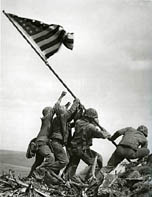 Marine aviation, which dates from 1912, also played a
part in the war effort, as Marine pilots flew day
bombing missions over France and Belgium. More than
30,000 Marines served in France and more than a third
were killed or wounded in six months of intense
fighting. During the
two decades before World War II, the Marine Corps began
to develop in earnest the doctrine, equipment, and
organization needed for amphibious warfare. The success
of this effort was proven first on Guadalcanal, then on
Bougainville, Tarawa, New Britain, Kwajalein, Eniwetok, Saipan, Guam, Tinian, Peleliu, Iwo Jima, and Okinawa. By
the end of the war in 1945, the Marine Corps had grown
to include six divisions, five air wings, and supporting
troops. Its strength in World War II peaked at 485,113.
The war cost the Marines nearly 87,000 dead and wounded,
and 82 Marines had earned the Medal of Honor.
Marine aviation, which dates from 1912, also played a
part in the war effort, as Marine pilots flew day
bombing missions over France and Belgium. More than
30,000 Marines served in France and more than a third
were killed or wounded in six months of intense
fighting. During the
two decades before World War II, the Marine Corps began
to develop in earnest the doctrine, equipment, and
organization needed for amphibious warfare. The success
of this effort was proven first on Guadalcanal, then on
Bougainville, Tarawa, New Britain, Kwajalein, Eniwetok, Saipan, Guam, Tinian, Peleliu, Iwo Jima, and Okinawa. By
the end of the war in 1945, the Marine Corps had grown
to include six divisions, five air wings, and supporting
troops. Its strength in World War II peaked at 485,113.
The war cost the Marines nearly 87,000 dead and wounded,
and 82 Marines had earned the Medal of Honor.
 While Marine units took part in the post-war
occupation of Japan and North China, studies were
undertaken at Quantico, Virginia, which concentrated on
attaining a "vertical envelopment" capability for the
Corps through the use of helicopters. Landing at
Inchon, Korea in September 1950, Marines proved that the
doctrine of amphibious assault was still viable and
necessary. After the recapture of Seoul, the Marines
advanced to the Chosin Reservoir only to see the Chinese
Communists enter the war. After years of offensives,
counter-offensives, seemingly endless trench warfare,
and occupation duty, the last Marine ground troops were
withdrawn in March 1955. More than 25,000 Marines were
killed or wounded during the Korean War.
While Marine units took part in the post-war
occupation of Japan and North China, studies were
undertaken at Quantico, Virginia, which concentrated on
attaining a "vertical envelopment" capability for the
Corps through the use of helicopters. Landing at
Inchon, Korea in September 1950, Marines proved that the
doctrine of amphibious assault was still viable and
necessary. After the recapture of Seoul, the Marines
advanced to the Chosin Reservoir only to see the Chinese
Communists enter the war. After years of offensives,
counter-offensives, seemingly endless trench warfare,
and occupation duty, the last Marine ground troops were
withdrawn in March 1955. More than 25,000 Marines were
killed or wounded during the Korean War.
 In July 1958, a brigade-size force landed in Lebanon
to restore order. During the Cuban Missile Crisis in
October 1962, a large amphibious force was marshaled but
not landed. In April 1965, a brigade of Marines landed
in the Dominican Republic to protect Americans and
evacuate those who wished to leave. The landing of the
9th Marine Expeditionary Brigade at Da Nang in 1965
marked the beginning of large-scale Marine involvement
in Vietnam. By summer 1968, after the enemy's Tet
Offensive, Marine Corps strength in Vietnam rose to a
peak of approximately 85,000. The Marine withdrawal
began in 1969 as the South Vietnamese began to assume a
larger role in the fighting; the last Marine ground
forces were out of Vietnam by June 1971.
In July 1958, a brigade-size force landed in Lebanon
to restore order. During the Cuban Missile Crisis in
October 1962, a large amphibious force was marshaled but
not landed. In April 1965, a brigade of Marines landed
in the Dominican Republic to protect Americans and
evacuate those who wished to leave. The landing of the
9th Marine Expeditionary Brigade at Da Nang in 1965
marked the beginning of large-scale Marine involvement
in Vietnam. By summer 1968, after the enemy's Tet
Offensive, Marine Corps strength in Vietnam rose to a
peak of approximately 85,000. The Marine withdrawal
began in 1969 as the South Vietnamese began to assume a
larger role in the fighting; the last Marine ground
forces were out of Vietnam by June 1971.
The Vietnam War, longest in the history of the Marine Corps, exacted a high cost as well with over 13,000 Marines killed and more than 88,000 wounded. In the spring of 1975, Marines evacuated embassy staffs, American citizens, and refugees in Phnom Penh, Cambodia, and Saigon, Republic of Vietnam. In May, Marines played an integral role in the rescue of the crew of the SS Mayaguez captured off the coast of Cambodia.
The mid-1970s saw the Marine Corps assume an increasingly significant role in defending NATO's northern flank as amphibious units of the 2d Marine Division participated in exercises throughout northern Europe. The Marine Corps also played a key role in the development of the Rapid Deployment Force, a multi-service organization created to insure a flexible, timely military response around the world when needed. The Maritime Prepositioning Ships (MPS) concept was developed to enhance this capability by prestaging equipment needed for combat in the vicinity of the designated area of operations, and reduce response time as Marines travel by air to link up with MPS assets.
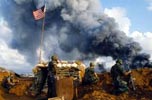 The 1980s brought an increasing number of terrorist
attacks on U.S. embassies around the world. Marine
Security Guards, under the direction of the State
Department, continued to serve with distinction in the
face of this challenge. In August 1982, Marine units
landed at Beirut, Lebanon, as part of the multi-national
peace-keeping force. For the next 19 months these units
faced the hazards of their mission with courage and
professionalism. In October 1983, Marines took part in
the highly successful, short-notice intervention in
Grenada. As the decade of the 1980s came to a close,
Marines were summoned to respond to instability in
Central America. Operation Just Cause was launched in
Panama in December 1989 to protect American lives and
restore the democratic process in that nation. Less than
a year later, in August 1990, the Iraqi invasion of
Kuwait set in motion events that would lead to the
largest movement of Marine Corps forces since World War
II. Between August 1990 and January 1991, some 24
infantry battalions, 40 squadrons, and more than 92,000
Marines deployed to the Persian Gulf as part of
Operation Desert Shield. Operation Desert Storm was
launched 16 January 1991, the day the air campaign
began.
The 1980s brought an increasing number of terrorist
attacks on U.S. embassies around the world. Marine
Security Guards, under the direction of the State
Department, continued to serve with distinction in the
face of this challenge. In August 1982, Marine units
landed at Beirut, Lebanon, as part of the multi-national
peace-keeping force. For the next 19 months these units
faced the hazards of their mission with courage and
professionalism. In October 1983, Marines took part in
the highly successful, short-notice intervention in
Grenada. As the decade of the 1980s came to a close,
Marines were summoned to respond to instability in
Central America. Operation Just Cause was launched in
Panama in December 1989 to protect American lives and
restore the democratic process in that nation. Less than
a year later, in August 1990, the Iraqi invasion of
Kuwait set in motion events that would lead to the
largest movement of Marine Corps forces since World War
II. Between August 1990 and January 1991, some 24
infantry battalions, 40 squadrons, and more than 92,000
Marines deployed to the Persian Gulf as part of
Operation Desert Shield. Operation Desert Storm was
launched 16 January 1991, the day the air campaign
began.
 The main attack came overland beginning 24 February
when the 1st and 2d Marine Divisions breached the Iraqi
defense lines and stormed into occupied Kuwait. By the
morning of February 28, 100 hours after the ground war
began, almost the entire Iraqi Army in the Kuwaiti
theater of operations had been encircled, with 4,000
tanks destroyed and 42 divisions destroyed or rendered
ineffective.
The main attack came overland beginning 24 February
when the 1st and 2d Marine Divisions breached the Iraqi
defense lines and stormed into occupied Kuwait. By the
morning of February 28, 100 hours after the ground war
began, almost the entire Iraqi Army in the Kuwaiti
theater of operations had been encircled, with 4,000
tanks destroyed and 42 divisions destroyed or rendered
ineffective.
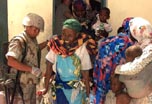 Overshadowed by the events in the Persian Gulf during
1990-91, were a number of other significant Marine
deployments demonstrating the Corps' flexible and rapid
response. Included among these were non-combatant
evacuation operations in Liberia and Somalia and
humanitarian lifesaving operations in Bangladesh, the
Philippines, and northern Iraq. In December 1992,
Marines landed in Somalia marking the beginning of a
two-year humanitarian relief operation in that
famine-stricken and strife-torn nation. In another part
of the world, Marine Corps aircraft supported Operation
Deny Flight in the no-fly zone over Bosnia-Herzegovina.
During April 1994, Marines once again demonstrated their
ability to protect American citizens in remote parts of
the world when a Marine task force evacuated U.S.
citizens from Rwanda in response to civil unrest in that
country.
Overshadowed by the events in the Persian Gulf during
1990-91, were a number of other significant Marine
deployments demonstrating the Corps' flexible and rapid
response. Included among these were non-combatant
evacuation operations in Liberia and Somalia and
humanitarian lifesaving operations in Bangladesh, the
Philippines, and northern Iraq. In December 1992,
Marines landed in Somalia marking the beginning of a
two-year humanitarian relief operation in that
famine-stricken and strife-torn nation. In another part
of the world, Marine Corps aircraft supported Operation
Deny Flight in the no-fly zone over Bosnia-Herzegovina.
During April 1994, Marines once again demonstrated their
ability to protect American citizens in remote parts of
the world when a Marine task force evacuated U.S.
citizens from Rwanda in response to civil unrest in that
country.
Closer to home, Marines went ashore in September 1994 in Haiti as part of the U.S. force participating in the restoration of democracy in that country. During this same period Marines were actively engaged in providing assistance to the Nation's counter-drug effort, assisting in battling wild fires in the western United States, and aiding in flood and hurricane relief operations.
The Marine Corps continued its tradition of innovation to meet the challenges of a new century. The Marine Corps Warfighting Laboratory was created in 1995 to evaluate change, assess the impact of new technologies on warfighting, and expedite the introduction of new capabilities into the operating forces of the Marine Corps. Exercises such as “Hunter Warrior,” and “Urban Warrior” were designed to explore future tactical concepts, and to examine facets of military operations in urban environments.
 During the late 1990's, Marine Corps units deployed
to several African nations, including Liberia, the
Central African Republic, Zaire, and Eritrea, in order
to provide security and assist in the evacuation of
American citizens during periods of political and civil
instability in those nations. Humanitarian
and disaster relief operations were also conducted by
Marines during 1998 in Kenya, and in the Central
American nations of Honduras, Nicaragua, El Salvador,
and Guatemala. In 1999, Marine units deployed to Kosovo
in support of Operation Allied Force. Soon after the
September 2001 terrorist attacks on New York City and
Washington, D.C., Marine units deployed to the Arabian
Sea and in November set up a forward operating base in
southern Afghanistan as part of Operation Enduring
Freedom.
During the late 1990's, Marine Corps units deployed
to several African nations, including Liberia, the
Central African Republic, Zaire, and Eritrea, in order
to provide security and assist in the evacuation of
American citizens during periods of political and civil
instability in those nations. Humanitarian
and disaster relief operations were also conducted by
Marines during 1998 in Kenya, and in the Central
American nations of Honduras, Nicaragua, El Salvador,
and Guatemala. In 1999, Marine units deployed to Kosovo
in support of Operation Allied Force. Soon after the
September 2001 terrorist attacks on New York City and
Washington, D.C., Marine units deployed to the Arabian
Sea and in November set up a forward operating base in
southern Afghanistan as part of Operation Enduring
Freedom.
 In 2002, the Marine Corps continued to play a key
role in the Global War on Terrorism. Marines operated in
diverse locations, from Afghanistan, to the Arabian
Gulf, to the Horn of Africa and the Philippines. Early
2003 saw the largest deployment of Marine forces since
the Persian Gulf War of 1990-91 when 76,000 Marines
deployed to the Central Command area for combat
operations against Iraq. The I Marine Expeditionary
Force, including Task Force Tarawa and the United
Kingdom’s 1st Armored Division, were the first
conventional ground units to enter Iraq in late March as
part of Operation Iraqi Freedom. Fixed-wing and
helicopter aircraft from the 3d Marine Air Wing provided
continuous close air and assault support to Marine and
coalition units as they drove deeper into Iraq. On the
ground, Marines from I MEF moved nearly 400 miles from
the Kuwait border to Baghdad and Tikrit, Iraq, and
eliminated the last organized resistance by Iraqi
military forces. Although I MEF would transition to
stabilization and security operations and then redeploy
to the U.S. by late September, I MEF began preparing for
a return to Iraq in early 2004. The
adaptability and reliability of Marine forces continued
to be highlighted around the world from the Horn of
Africa to Haiti and to the Philippines.
In 2002, the Marine Corps continued to play a key
role in the Global War on Terrorism. Marines operated in
diverse locations, from Afghanistan, to the Arabian
Gulf, to the Horn of Africa and the Philippines. Early
2003 saw the largest deployment of Marine forces since
the Persian Gulf War of 1990-91 when 76,000 Marines
deployed to the Central Command area for combat
operations against Iraq. The I Marine Expeditionary
Force, including Task Force Tarawa and the United
Kingdom’s 1st Armored Division, were the first
conventional ground units to enter Iraq in late March as
part of Operation Iraqi Freedom. Fixed-wing and
helicopter aircraft from the 3d Marine Air Wing provided
continuous close air and assault support to Marine and
coalition units as they drove deeper into Iraq. On the
ground, Marines from I MEF moved nearly 400 miles from
the Kuwait border to Baghdad and Tikrit, Iraq, and
eliminated the last organized resistance by Iraqi
military forces. Although I MEF would transition to
stabilization and security operations and then redeploy
to the U.S. by late September, I MEF began preparing for
a return to Iraq in early 2004. The
adaptability and reliability of Marine forces continued
to be highlighted around the world from the Horn of
Africa to Haiti and to the Philippines.
 Across the U.S., Marine units from both coasts fought
and contained wildfires, and also supported hurricane
relief efforts in various parts of the country. In
December, 2004, a tsunami struck numerous nations in the
Indian Ocean region killing more than 150,000 and
causing enormous devastation. Marine units from III MEF
were immediately deployed to Thailand, Indonesia, and
Sri Lanka to assist in disaster relief operations.
In early 2005, the II Marine Expeditionary Force
replaced I MEF in Iraq as the primary focus began to
shift to partnership operations with the Iraqi Security
Forces. Marine units continued to provide air and ground
support to Operation Enduring Freedom in Afghanistan.
Closer to home, the flexibility and responsiveness of
the Navy/Marine team was exhibited during September and
October when nearly 3000 Marines and sailors conducted
search and rescue, humanitarian relief, and disaster
recovery operations in Louisiana and Mississippi in the
aftermath of hurricanes Katrina and Rita.
Across the U.S., Marine units from both coasts fought
and contained wildfires, and also supported hurricane
relief efforts in various parts of the country. In
December, 2004, a tsunami struck numerous nations in the
Indian Ocean region killing more than 150,000 and
causing enormous devastation. Marine units from III MEF
were immediately deployed to Thailand, Indonesia, and
Sri Lanka to assist in disaster relief operations.
In early 2005, the II Marine Expeditionary Force
replaced I MEF in Iraq as the primary focus began to
shift to partnership operations with the Iraqi Security
Forces. Marine units continued to provide air and ground
support to Operation Enduring Freedom in Afghanistan.
Closer to home, the flexibility and responsiveness of
the Navy/Marine team was exhibited during September and
October when nearly 3000 Marines and sailors conducted
search and rescue, humanitarian relief, and disaster
recovery operations in Louisiana and Mississippi in the
aftermath of hurricanes Katrina and Rita.
Today's Marine Corps stands ready to continue in the proud tradition of those who so valiantly fought and died at Belleau Wood, Iwo Jima, the Chosin Reservoir, and Khe Sanh. Combining a long and proud heritage of faithful service to the nation, with the resolve to face tomorrow's challenges will continue to keep the Marine Corps the "best of the best."
Courtesy of U.S. Marine Corps History Division